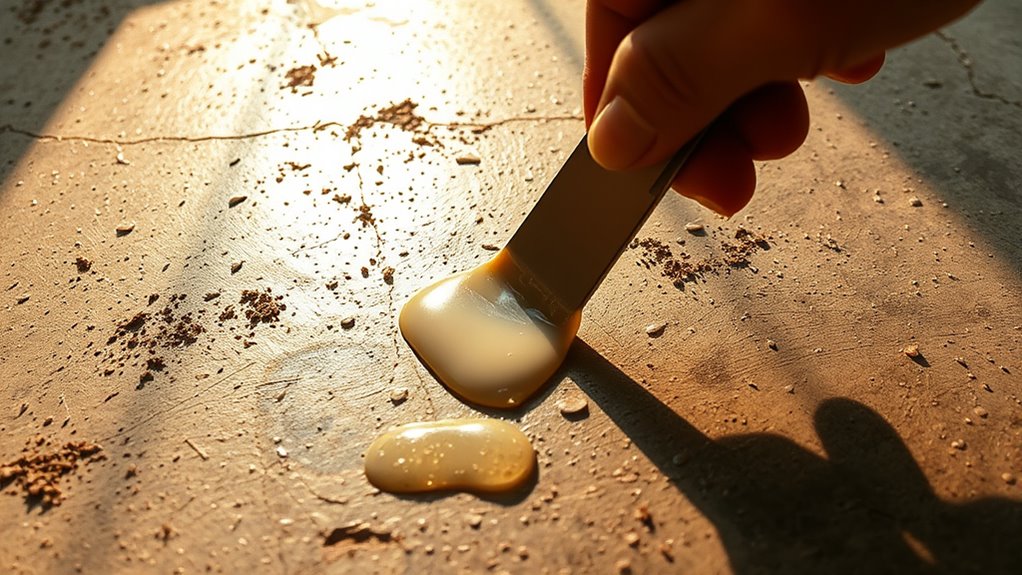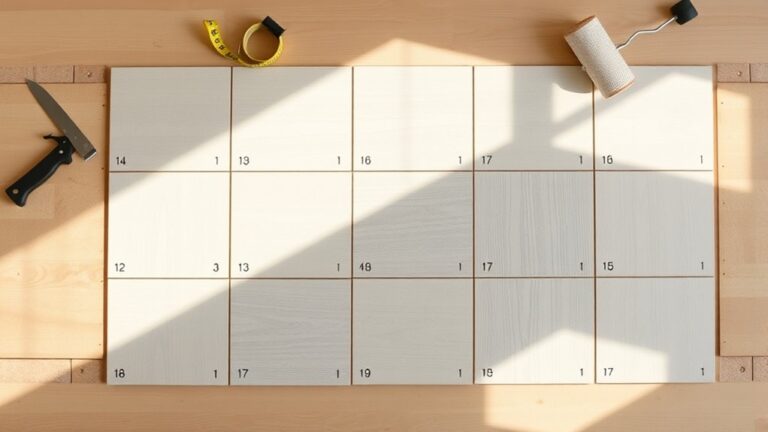To get glue off a concrete floor, first identify the glue type by testing its hardness and reaction to solvents like acetone. Use heat from a hairdryer or heat gun to soften stubborn glue, then gently scrape with plastic tools to avoid damaging the surface. After scraping, apply a concrete-safe adhesive remover to tackle residue and scrub with a stiff brush. Rinse thoroughly and let it dry. If you want to clean more efficiently and prevent future issues, exploring proper techniques will help.
Assessing the Type of Glue on Your Concrete Floor
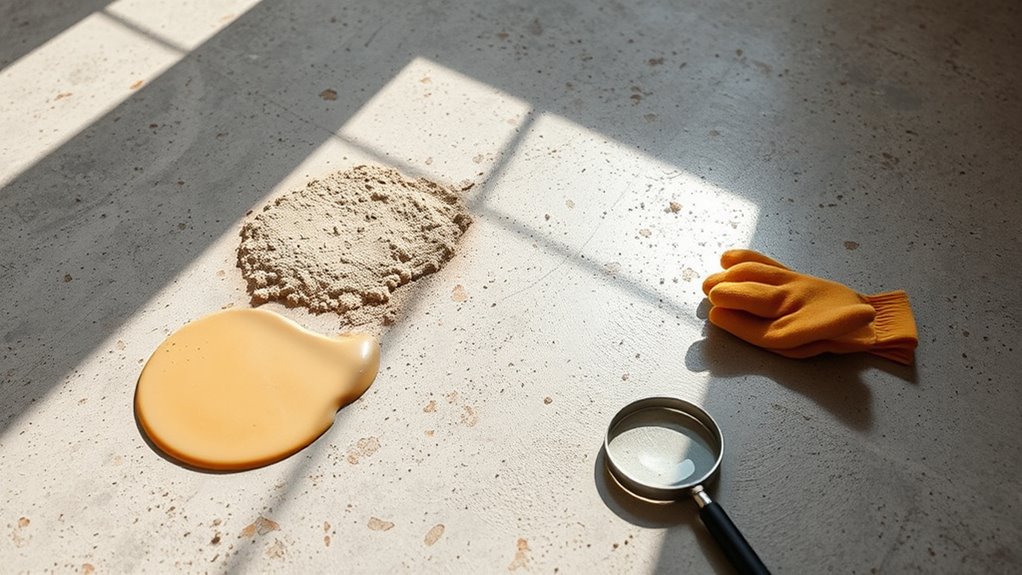
How do you identify the type of glue on your concrete pavimento? Start by examining the glue’s texture and color—common types include epoxy, urethane, and acrylic adhesives, each with distinct characteristics. You can perform simple tests to understand its adhesive strength; try gently scraping the surface with a putty knife or applying a small amount of solvent like acetone in an inconspicuous spot. If the glue softens or dissolves, you’re likely dealing with a water-based or acrylic adhesive. If it resists, it might be epoxy or urethane, requiring stronger solvents or mechanical removal. Accurate identifying glue types helps you choose the most effective removal method without damaging your floor. Testing adhesive strength early on saves time and empowers you to regain control over your space efficiently.
Gathering Tools and Materials Needed for Glue Removal
Before you start, make sure you have the right tools and cleaning materials on hand. You’ll need essentials like a scraper, a wire brush, and a reliable adhesive remover suited for concrete. Having these ready will make the glue removal process faster and more effective.
Essential Tools Checklist
You’ll need a few essential tools to tackle glue removal from your concrete floor effectively. Start with a sturdy scraper or putty knife to lift and peel away adhesive. A heat gun or hairdryer helps soften stubborn glue, making it easier to remove. Gloves and safety goggles are non-negotiable—vital safety precautions protect you from chemical exposure and debris. Have a stiff-bristle brush handy for scrubbing residue after scraping. A bucket and mop are important for applying and rinsing cleaning solutions, followed by effective drying methods like fans or open windows to prevent moisture buildup. Finally, a plastic scraper or razor blade can assist in detailed spots. Gathering these tools upfront puts you in control, ensuring a smooth, efficient glue removal process without unnecessary delays.
Recommended Cleaning Materials
Although having the right tools is essential, selecting effective cleaning materials will make removing glue from your concrete floor much easier. You don’t want to be stuck with harsh chemicals or ineffective options. Choose materials that respect your space and your health, offering freedom from toxic fumes. Consider these reliable picks:
- Eco friendly solutions like citrus-based solvents that break down glue without harming the environment
- Commercial products specifically formulated for concrete, ensuring powerful adhesion removal
- Heavy-duty degreasers to tackle stubborn residue quickly
- Absorbent rags or microfiber cloths for thorough cleanup without scratching
Preparing the Concrete Surface for Glue Removal
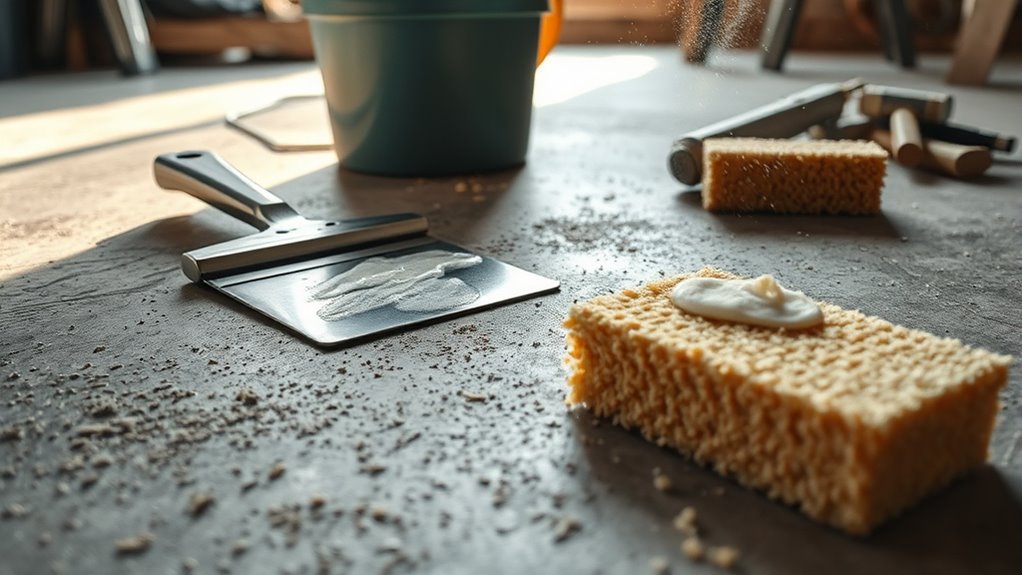
Since concrete is porous and can easily trap adhesive residue, you’ll need to thoroughly clean and dry the surface before attempting glue removal. Start with proper surface preparation by sweeping away loose dirt and debris. Next, use a stiff-bristle brush combined with a concrete cleaner or a mild detergent solution to scrub the area. This concrete cleaning step is essential to break down oils, dust, and grime that might interfere with glue removal products. After scrubbing, rinse the floor with clean water and allow it to dry completely. Avoid leaving moisture, as it can prevent effective adhesion of solvents or peeling agents. By preparing the concrete surface meticulously, you guarantee that your glue removal efforts will be more efficient and less time-consuming, giving you the freedom to restore your floor with confidence.
Using Heat to Soften and Remove Glue
When glue has hardened on your concrete floor, applying heat can soften the adhesive, making it easier to remove. Heat application loosens the bond, allowing you to scrape off glue without damaging the surface. Use a heat gun or a hairdryer set on high to focus warmth on the glue spots. Remember these key points for effective glue softening:
Applying heat softens hardened glue on concrete, easing removal without damaging the surface.
- Keep the heat source moving to avoid overheating the concrete.
- Test a small area first to verify the floor withstands the heat.
- Use a putty knife or scraper to gently lift softened glue.
- Work in a well-ventilated area to avoid inhaling fumes.
With controlled heat application, you gain control over stubborn glue, freeing your floor with less effort and no harsh chemicals.
Applying Solvents Safely to Dissolve Glue
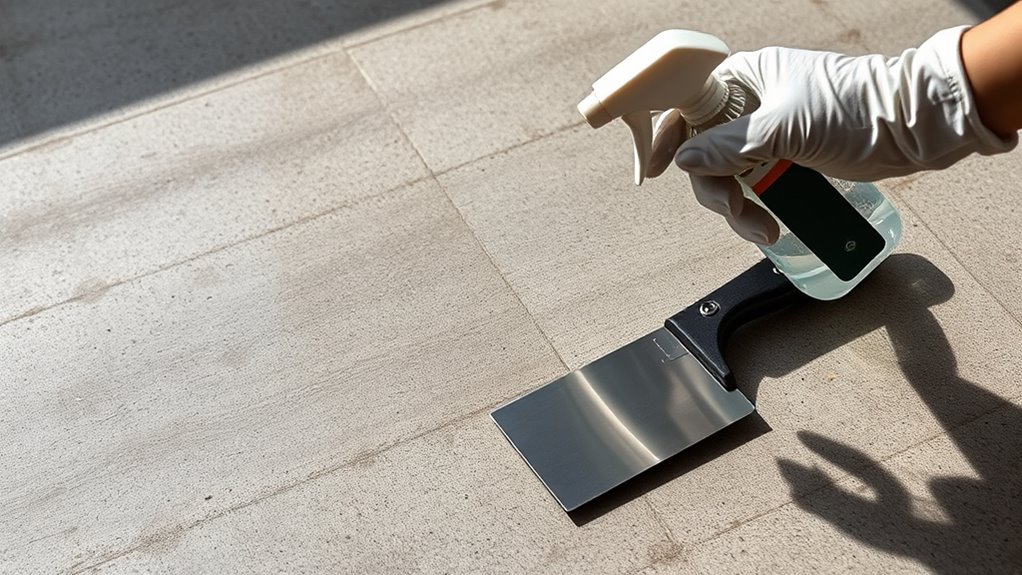
If heat alone doesn’t loosen the glue enough, solvents can help break down the adhesive for easier removal. Choose the right solvent type based on the glue and concrete to avoid damage. Always prioritize safety precautions—work in a well-ventilated area, wear gloves, and protect your eyes.
| Solvent Type | Use Case |
|---|---|
| Acetone | Effective on many adhesives |
| Mineral Spirits | Gentle, for less stubborn glue |
| Citrus-based | Eco-friendly, mild on surfaces |
| Commercial Glue Remover | Strong, for tough residues |
Apply solvents sparingly. Let the solvent sit a few minutes to dissolve the glue, then proceed carefully. Your freedom to restore your floor depends on respecting both the product and your safety.
Scraping Off Glue Without Damaging the Concrete
To remove glue without harming your concrete, pick the right scraping tools like plastic scrapers or putty knives instead of metal ones. Use gentle, controlled motions to lift the softened glue without gouging the surface. Taking your time guarantees the concrete stays intact while you clear away the residue.
Choose Proper Scraping Tools
Selecting the right scraping tools is essential to remove glue effectively without harming your concrete floor. Your freedom to restore the surface depends on careful choice of tool materials and design. Opt for tools that support precise scraping techniques, giving you control without risking damage.
Choose from:
- Plastic scrapers to avoid scratching and maintain surface integrity
- Razor blade scrapers with replaceable blades for stubborn glue
- Putty knives with flexible, non-metal blades for gentle removal
- Wire brushes for textured concrete, used cautiously to prevent gouging
Each tool offers a balance between strength and safety. Avoid metal scrapers with hard edges as they can irreversibly scar concrete. By selecting proper scraping tools, you empower yourself to restore your floor with confidence and preserve its original look.
Use Gentle Scraping Techniques
Start by applying steady, gentle pressure when scraping glue off your concrete floor. Using gentle techniques guarantees you remove adhesive without damaging the surface beneath. Avoid aggressive scraping methods that can gouge or scratch the concrete. Instead, opt for tools like plastic scrapers or putty knives designed to protect the floor. Work slowly and methodically, focusing on lifting the glue rather than forcing it. If the glue resists, soften it with a recommended solvent before continuing. Remember, the goal is to free your floor from glue while preserving its integrity. By mastering gentle scraping techniques, you maintain your concrete’s durability and appearance, giving you the freedom to transform your space without worry. Keep your approach controlled, patient, and precise for the best results.
Cleaning Residue After Glue Removal
Although you’ve removed most of the glue, residue often remains embedded in the concrete’s pores or on its surface. Effective residue removal demands targeted cleaning techniques that won’t damage your floor. Start by applying a concrete-safe adhesive remover or a mixture of warm water and mild detergent. Scrub with a stiff brush to agitate stubborn spots. Then, rinse thoroughly with clean water and dry the area completely.
Remove stubborn glue residue gently with a concrete-safe remover, scrubbing and rinsing thoroughly to protect your floor.
Remember, your freedom to use the space depends on thorough cleaning:
- Avoid harsh chemicals that eat into concrete
- Use protective gloves to safeguard your hands
- Test cleaning solutions on a small patch first
- Be patient; residue removal takes time
These steps guarantee your floor is clean, ready for whatever you envision next.
Preventing Glue Residue in Future Flooring Projects
When you plan your flooring project carefully, you can prevent glue residue from becoming a future headache. Start by selecting adhesives specifically designed for your flooring type, ensuring easy removal later. Apply glue sparingly—excess adhesive often leads to stubborn residue. Use protective barriers like release liners between the glue and concrete whenever possible. During installation, maintain a clean workspace to avoid spreading adhesive beyond intended areas. After the project, promptly remove any excess glue before it cures fully. These preventive measures save you time and effort down the road. By integrating them into your process, you safeguard your concrete floor and simplify future flooring updates. Taking these steps gives you the freedom to change or upgrade your flooring without battling leftover glue residue.

